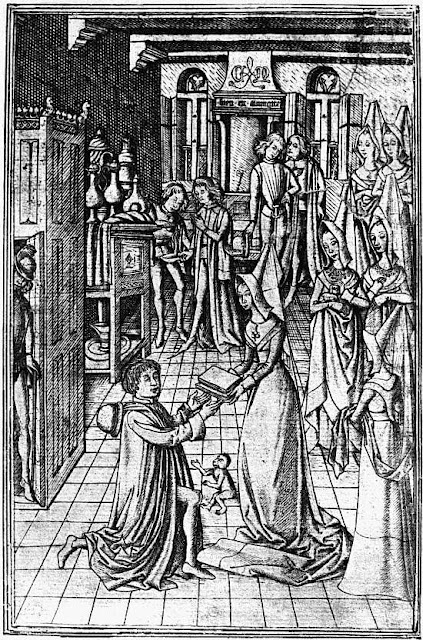William Caxton (ca. 1415~1422 – 1492) set up a printing press in Bruges in 1473, in collaboration with a Fleming, Colard Mansion.
The first book to be printed in English was Recuyell of the Historyes of Troye, a translation of a French book by Caxton himself. He published his version around 1474, at a time when most books were printed in Latin, in either Ghent or Bruges, Belgium. Below is an engraving showing Caxton presenting a copy of Recuyell of the Historyes of Troye to Margaret of York.
The first book to be printed in English was Recuyell of the Historyes of Troye, a translation of a French book by Caxton himself. He published his version around 1474, at a time when most books were printed in Latin, in either Ghent or Bruges, Belgium. Below is an engraving showing Caxton presenting a copy of Recuyell of the Historyes of Troye to Margaret of York.
 |
The first book known to have been produced by Caxton at Westminster was an edition of Chaucer's The Canterbury Tales. He was also the first English retailer of printed books (his London contemporaries in the same trade were all Flemish, German or French).
William Caxton produced the first advertisement in English on his printing press in Westminster Abbey, London in 1477. The advertisement offered a prayer book and it claimed that the book is "good chepe."
William Caxton is a monumental figure in English literature, not only for printing but also for his translations. On March 26, 1484, he produced the first printed English translation of Aesop's Fables.
Just three weeks before the Wars of the Roses ended at the Battle of Bosworth in 1485, William Caxton put on sale his newly printed edition of Sir Thomas Malory’s prose epic Le Morte d’Arthur. Despite running to 860 pages it was an instant best-seller. Malory, as Caxton had explained, had “taken” the tales “out of certain books of French”, then “reduced” them into English.
Caxton is credited with standardising the English language through printing. This facilitated the expansion of English vocabulary, the regularisation of inflection and syntax, and a widening gap between the spoken and the written word.
It is asserted that the spelling of "ghost" with the silent letter h was adopted by Caxton due to the influence of Flemish spelling habits.
The Lyme Missal, a prayer book printed by William Caxton in 1487, was owned by just one family from 1508 to 2008 when it was purchased for £465,000 by the National Trust.

No comments:
Post a Comment